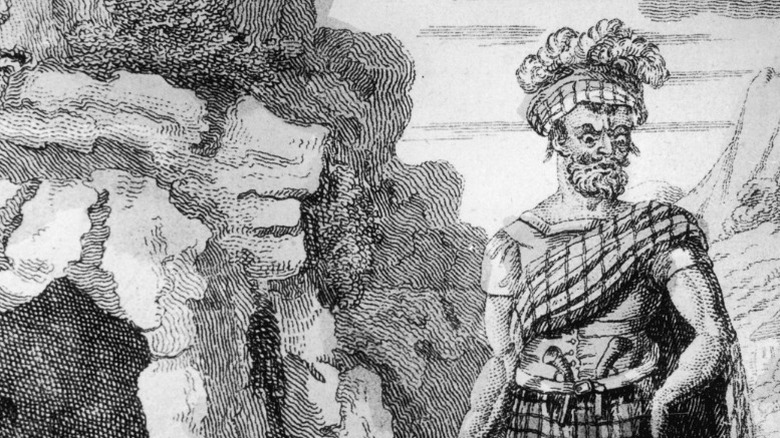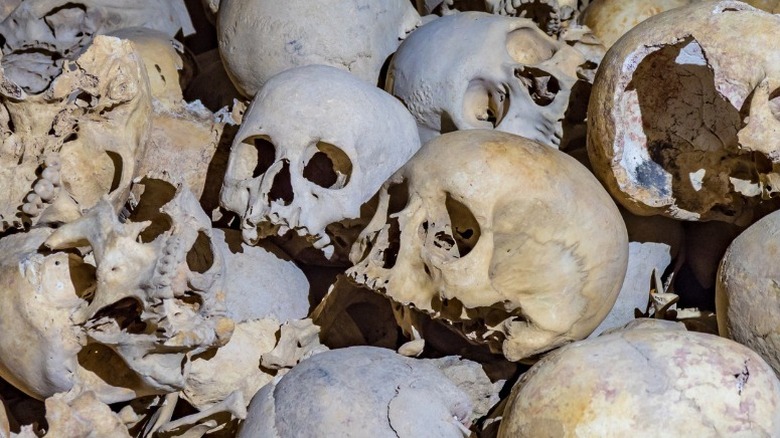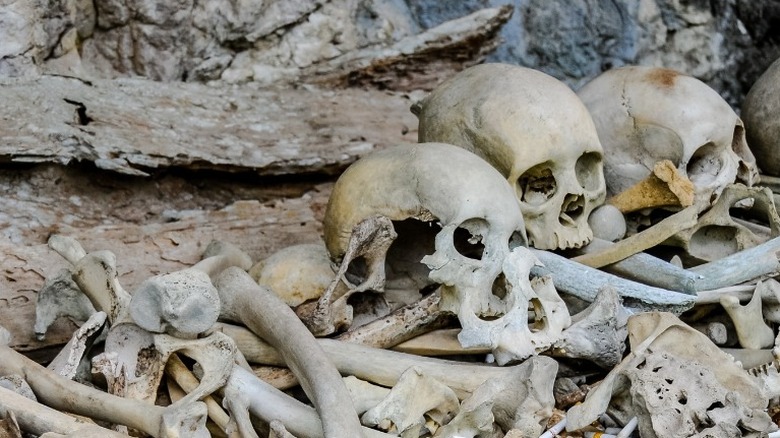How An Ancient Scottish Legend Inspired This Horror Classic
The creative minds that have pieced together the most terrifying films do not always draw from original material. Stanley Kubrick's 1980 horror classic "The Shining" was based on the bestselling novel by Stephen King. The film "The Haunting" and Netflix miniseries "The Haunting of Hill House" were based on the 1959 Shirley Jackson novel. The real talent in making a horror film might not lie in creating an original story, but by taking someone else's words and turning them into haunting visions that are projected onto a big screen.
Horror filmmakers don't always rely on the written word for inspiration, either. Some will look for real-life examples of terror and creatively transpose them into art. Many might not be aware that killer Ed Gein inspired not one, but at least seven horror films in pop culture, according to Biography. "Psycho," "The Texas Chainsaw Massacre," and "The Silence of the Lambs" all capture Gein's chilling essence, delighting horror fans with the shocks and shudders as scenes unfold.
Some horror filmmakers have pulled from the legends of the past to guide their celluloid creations. While some of these films will focus on legendary beasts from our ancestors' tales, others will be centered around human figures that may (or may not) have existed in real life.
Such is the case with one of Wes Craven's early film endeavors, the 1977 film "The Hills Have Eyes." For inspiration, Craven looked to an old Scottish legend about a man named Alexander "Sawney" Bean.
The legend of Sawney Bean
The roots of the Sawney Bean legend are tangled so much that it's really difficult to say where they began. Ancient Origins tells us that the subject of the old Scottish folk stories was born in either the early 15th century or the latter part of the 16th century. But no matter when (or if) he really existed, the mark his tale left on Scottish folklore might give any traveler some pause when traversing the backcountry.
Bean reportedly came from a salt-of-the-earth family, but he was a bit of a slouch, so his father would often beat him. As a young adult, Bean met and married a woman named Agnes Douglas, and the two set off for a life in a remote cave near the Ayrshire coast. Rather than get a job, Bean supported the two of them by preying on travelers that passed over a nearby road. Bean would stealthily attack his unsuspecting victims, beating them and taking whatever they carried of value. Of course, Bean couldn't just let them go. To evade any suspicions, he would murder the poor souls. To kill two birds with one stone, Bean and his wife would cook and eat the people he killed so that they could also not rely on trips to town for food and supplies.
Bean and Douglas soon began to add to their household. She bore him child after child until the cannibal couple had amassed quite the brood.
The gruesome killings continue
Over time, Sawney Bean's little family apparently grew to include 14 children. Eventually, this supposedly led to over 30 grandchildren. Without much contact with the outside world, the third generation of Bean's nightmarish clan was largely the product of incest (via Ancient Origins).
Bean and his murderous family carried on robbing, murdering, and eating unsuspecting passersby for several years. The disappearances of the townsfolk in neighboring communities certainly didn't go unnoticed. Nor did the many human bones that would wash ashore, tossed carelessly into the sea by Bean and his kin.
All That's Interesting says that over 25 years, the Beans were responsible for as many as 1,000 deaths. But like all good times, this one came to an eventual end. In a common version of the legend, Bean's small army of flesh-hungry bandits launched an attack on a husband and wife who were approaching on horseback. After the attack, the woman was killed. But the man proved to be too much for the Bean clan. He fought back with both a pistol and a sword, keeping the cannibals at bay until he was joined by a group of travelers that were leaving a nearby fair.
Word evidently got back to the king, who sent his forces out to capture the Beans. It is said that Bean and his family were brought to trial and sentenced to death. The woman were burned and the men were dismembered.
Bean inspired Wes Craven to write The Hills Have Eyes
The 1977 film "The Hills Have Eyes" follows the Carters, a vacationing family, across the desert in their car and travel trailer (per Mubi). When stopping for fuel, the proprietor warns the Carter family to stay on the main road until they safely reach their destination. Ignoring the old man's advice, the Carters decide to take a shortcut. It would be the worst mistake they ever made.
After their car crashes off the side of the road, the family is left stranded. The family patriarch, Bob Carter, hoofs it back to Fred's service station to find help from the old man whom he had met earlier. After telling Fred where he crashed, Bob learns why he was warned to not deviate from his route. Fred passed on the story of his son, Jupiter, who years before had murdered his own sister and killed off the family's livestock. Fred took Jupiter into the nearby hills and severely beat him and left him to die.
But Jupiter didn't die from his injuries. He survived and took up with a local sex worker and began a dysfunctional family of his own, deep in the hills. His bride gave birth to three boys and one girl, all of whom would survive by attacking travelers who came too close to their lair. (Sound familiar?) Jupiter's clan then begins their attack on the Carter family, killing them one by one in the most horrific ways imaginable.
The two tales are very similar
BBC reports that Wes Craven used the legend of Sawney Bean as a direct inspiration for the script. "The Hills Have Eyes" had antagonists that were much smaller in number than the ones told about in the Bean legends, but there are a lot of similarities.
Like Bean, Jupiter was a real screwup at home and was severely beaten by his father. Each figure left their childhood homes for a new life of secluision and met mates who would be partners in their brutality. As time went by, both Bean and Jupiter were able to increase their family's numbers, though Bean had a definite size advantage here. But had Jupiter and his family been able to survive long enough to have a third generation fueled by rampant, unchecked inbreeding, his bloodthirsty kinfolk might have rivaled that of the Scottish legend.
The two clans meet their ends similarly as well. The Beans' savagery came to a halt when they attacked a man and wife, killing the wife in the process. In "The Hills Have Eyes," the husband and wife are killed, but their adult children that are traveling with them lead an attack at the cannibals' cave and get their revenge.
The legend and the film both conjure up some of the worst fears for travelers. The peacefulness of vacationing or migrating between cities is horrifically interrupted by violent attacks from societal outcasts that are barely human. As time would pass, "The Hills Have Eyes" became quite the commodity for the horror industry, showing that even among the most violent films there is room for growth.
Sequels and remakes
"The Hills Have Eyes" spawned quite a following, cementing itself as a cult favorite among many horror fans. The film spawned a 1984 sequel, following the exploits of the surviving members of Jupiter's clan. But the horror didn't stop there.
In 2006, Wes Craven's classic film was adapted into a higher-budget remake. The film, directed by Alexandre Aja, had an estimated $15 million budget. Behind stars Ted Levine and Kathleen Quinlan, it had a modest run in theaters across the country. After its run on the big screen, the total worldwide gross for the movie was over $70 million (per IMDb).
The following year, a sequel to the remake was released. "The Hills Have Eyes II" had a budget similar in scope to the previous year's film, but didn't fare quite as well in box office receipts. During its theatrical run, the movie only brought in an estimated $37 million (per IMDb).
Love the films or hate them, they've stayed relevant in horror pop culture for over four decades and counting. While they might not have the staying power of the legends that surround Sawney Bean, they've certainly introduced new generations of folklore enthusiasts to his morbid tales of murder and cannibalism.





